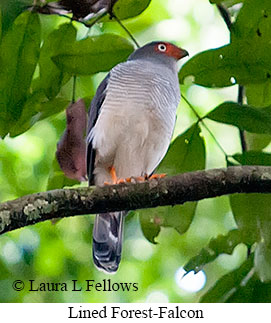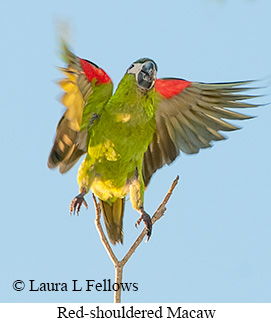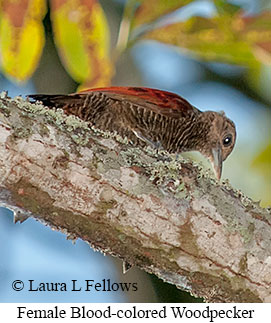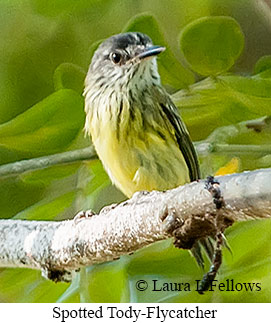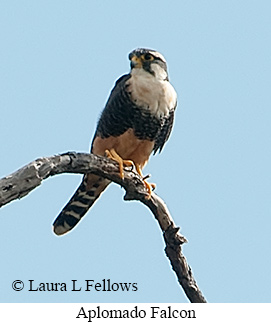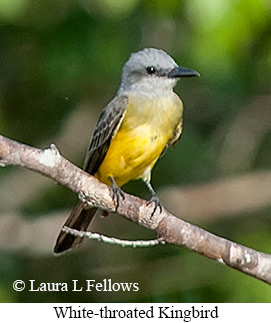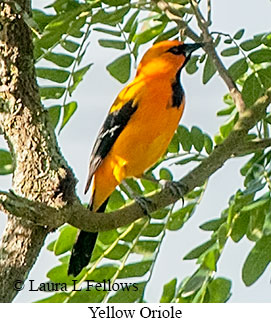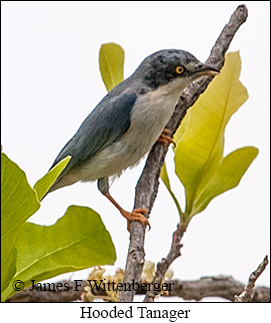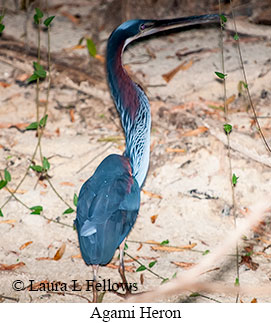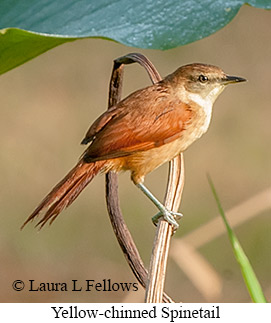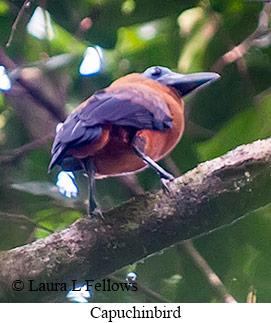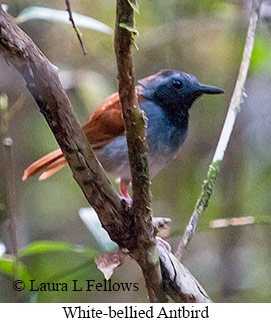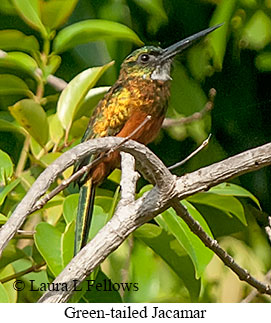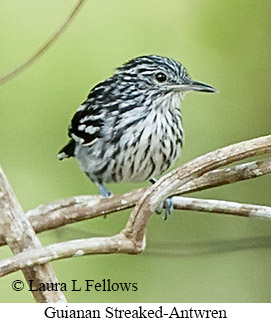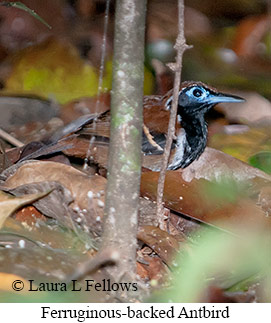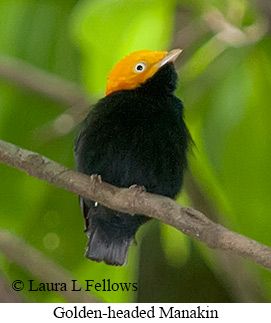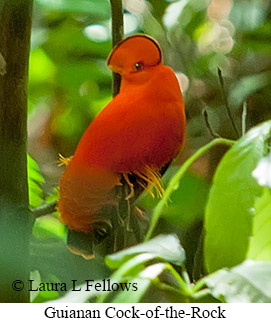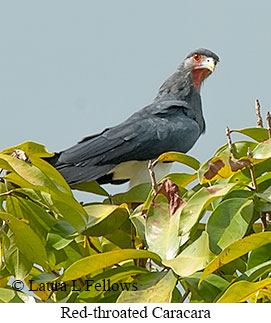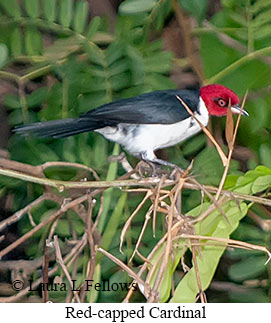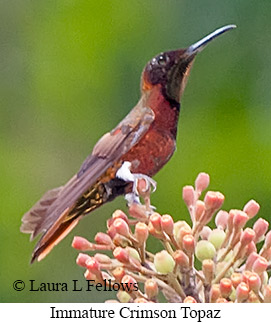GUYANA BIRDING TRIP REPORT

TRIP REPORT
GUYANA
| Start: | 11/10/2008 |
| End: | 11/21/2008 |
| Duration: | 12 days |
| #Species: | 274 |
| #Endemics: | 0 |
| #Heard Only: | 17 |
2008 Guyana Scouting Trip
TOUR DESCRIPTION
Guyana is an emerging tour destination for birders from the UK, US, and elsewhere. The country is best known in the UK since Guyana was a British colony until 1966, so most birders currently visiting the country are from there. Nevertheless, a strong initiative to promote tourism, especially among birders, is being conducted by the Guyana Tourism Authority with funding from USAID and other sources to promote awareness and attract interest within the US and other countries. Guyana offers superb birding opportunities and features a substantial number of specialty birds found only in northeastern South America and the Guianan Shield geological area.
We decided to do a scouting trip to further assess birding opportunities and perfect an itinerary after one of us (Jim) visited Guyana in April 2008 on a familiarization trip sponsored by the Guyana Tourism Authority (see our earlier trip report of that tour). We saw fewer species than the group saw during the April fam trip. As a scouting trip, we expected and indeed encountered travel inefficiencies that impacted our birding success. We also spent time photographing birds, which reduced our species count for this trip. In addition, we didn't put much effort into looking for nightjars, and with fewer eyes looking, it was only natural that we saw fewer species. Despite our lower species count, we consider our trip highly successful in that we obtained many usable photographs and we now know how to do a Guyana birding tour both well and economically.
Our tour began with a 2-hour visit to the Botanical Gardens in Georgetown. The gardens are an excellent place to see and photograph macaws and parrots. These birds are vocal and omnipresent. Species we found included Blue-and-yellow Macaw, Red-shouldered Macaw, Festive Amazon, Yellow-crowned Amazon, Orange-winged Amazon, and Mealy Amazon. The gardens are also the best place to find the range-restricted Blood-colored Woodpecker. With a little walking we had excellent looks at two females. Another target species is the Yellow-chinned Spinetail, and we found and photographed several individuals including one who perched right in the open. Other notable birds we saw at the Botanical Gardens and in the Georgetown area were Peregrine Falcon, which streaked past us overhead, White-chested Emerald, White-barred Piculet, Black-crested Antshrike, Small-billed Elaenia, Spotted Tody-Flycatcher, Brown-crested Flycatcher, Black-capped Donacobius, Pale-breasted Thrush, Violaceous Euphonia, Turquoise Tanager, and Carib Grackle.
We missed some important birding locales along the coast, which are worth a visit if a person has an extra day to spend. The most important places near Georgetown are Hope Beach, where Scarlet Ibis can be found along with various herons, shorebirds, and gulls, the Mahaicorry River where Hoatzin can be found by traveling down a side road paralleling the river, and the Abary River where a trail leads through some open areas to mangroves where the highly endangered Rufous Crab-Hawk can be reliably seen. Other target birds in this area include Long-winged Harrier, Crane Hawk, Green-and-rufous Kingfisher, Pale-breasted Spinetail, Point-tailed Palmcreeper, Black-crested Antshrike, Northern Scrub Flycatcher, and Velvet-fronted Grackle.
The Botanical Gardens were just a warm-up for truly outstanding birding in the interior. We flew by 13-passenger aircraft to Lethem, located on the Guyana/Brazil border in the south. During our 2-hour flight we flew over large tracts of nearly unspoiled tropical rainforest and large expanses of natural savanna intersected by tree-lined rivers. We were met by our birding guide Wally Prince and our local host Duane Defreitas in Lethem. Duane is the current manager of Dadanawa, the world's largest cattle ranch at 1750 sq. miles, half of which is inundated during rainy season from around May-August.
We drove south from Letham by 4-wheel drive Land Cruiser for 3 ¾ hours via jeep track, birding en route. The habitat is largely Moriche Palm scrub and savanna with forested hillocks interspersed throughout. We spotted several Aplomado Falcons along the way and had superb changes to photograph these magnificent birds. We saw several Jabirus, which are scattered all over the savanna in low-lying areas where water is present or nearby. We also had good looks at Buff-necked Ibis, which are quite common. Southern Lapwings are everywhere. We had the good fortune of finding a Pearl Kite perched on a tree snag in the open. Amazingly, Screaming Pihas are ubiquitous, even when the only trees are along gullies and creeks. At one spot we saw numerous swifts including a Tepui Swift, which is normally hard to see outside Venezuela but sometimes occurs in Guyana, mixed in with Fork-tailed Palm Swifts and Short-tailed Swifts. Other interesting birds we saw en route were Common Black-Hawk, Lesser Nighthawk, Amazonian White-tailed Trogon, White-headed Marsh-Tyrant, Bicolored Wren, Yellow-bellied Seedeater, and Red-breasted Blackbird.
The following morning we went out birding in the savanna and along riverine forest edges. We had to skip a nice trail through riverine forest because Laura was still recovering from some foot surgery, so we missed some birds that can be seen in that habitat. Normally our birding groups would do that trail. We did see several flocks of Red-shouldered Macaw and Yellow-crowned Amazon and had good looks when they flew overhead. Many Brown-throated Parakeets were flying about and making a ruckus. We had good looks at a Crimson-crested Woodpecker and spotted a Ringed Woodpecker as it flew across an open area to a distant forest patch. We ferreted out a White-fringed Antwren in the scrub and found several Guianan Gnatcatchers. Other birds we saw included Pale-legged Hornero, White-throated Kingbird, Fork-tailed Flycatcher, Burnished-Buff Tanager, Lesser Seed-Finch, Grassland Sparrow, and Yellow Oriole.
Dadanawa is a working cattle ranch, and we had arranged to spend some time this morning watching and photographing the vaqueros at work. They were busy separating cows, bulls, and heifers into separate corals through a system of fences and gates, all the while taking a census based on identifying numbers tattooed on their ears. It was great fun making photographs among the dust and ruckus while the vaqueros hammed it up for our camera. They roped a couple of cows and rode them rodeo style for our benefit. We didn't stay for the castrating of young bulls or the branding, which was next up on the agenda.
In late morning we set off to look for Red Siskin, a bird driven to the brink of extinction in Venezuela and Columbia by trappers catching the birds for the pet trade. A population of about 4000 individuals scattered around fairly remote areas of Dadanawa are nearly the only birds known to remain in the wild. The two most accessible areas to see them are 1 ½ and 2 ½ hours from the ranch buildings by 4-wheel drive along jeep tracks and cross-country across the savanna. We chose the farther group to visit because it's more of a sure thing to find them there. We needed the remainder of the day to get to the site and back, but we found the excursion well worth it. We found several females and a couple males, and enjoyed great views of these stunning birds. We also had a good look at Hooded Tanager at the siskin site, the only time we saw this species. We spotted a variety of other birds during the excursion, including several coveys of Crested Quail that flushed and scurried for cover, several fine looks at White-tailed Hawks, many Southern Lapwings, Glittering-throated Emerald, Bicolored Wrens, which are quite common, White-bellied Piculet, Burnished-buff Tanager, Grassland Sparrow, and Red-breasted Blackbird. South American Snipe is a possibility in the area but is harder to find during dry season.
From Dadanawa we drove back to Lethem next day, where we were met by Dianne McTurk from Karanambu. We had hoped to look for Rio Branco Antbird and Hoary-throated Spinetail near Lethem, but that didn't work out this trip. A person needs more time and some playback tapes to reliably find these very range-restricted species. We spent the afternoon driving with Dianne and her driver to Karanambu, a large ranch several hours north of Lethem by road along the Rupununi River. The drive is rather monotonous across open savanna, and we decided it would be much better to do that transfer by plane next time.
We stayed two nights at Karanambu, and greatly enjoyed Dianne's company while we were there. Dianne is a fascinating woman known world-wide for her efforts at rescuing orphaned Giant Otter pups. Our first afternoon at Karanambu Laura went out on the river with Dianne with a few other guests and found an Agami Heron along with some predictable herons, egrets, and kingfishers. She also saw some rehabilitated Giant Otters, but wild otters were nowhere to be found in their usual haunts. Meanwhile, Jim went out with Wally on a trail through riverine forest paralleling the river. They also found an Agami Heron lurking in a tangle of thickets along the river. Other birds they saw were a female Blue-backed Manakin and the only White-winged Becard seen on the trip. They heard an Amazonian Pygmy-Owl but couldn't lure it in with playback.
The following morning we drove out onto the savanna. Laura and Wally had quick looks at an Undulated Tinamou! Some trackers at the ranch had gone out early and found a Giant Anteater, which we were able to photograph as it headed to its day-time sleeping hideout. Our primary target bird was Bearded Tachuri, a small flycatcher found in open savanna. We found and photographed several individuals near a marshy wetland. As we were viewing the Tachuri, a Pinnated Bittern flew over the marsh and landed in some dense marsh grass. We saw several Jabirus and had the good fortune of finding 3 Short-tailed Ibis, a beautiful black ibis with red bill, lores, and legs. It was the first time our guide had seen this magnificent bird, which is only a seasonal visitor, because he has rarely had occasion to visit Karanambu before. With some effort we found a juvenile Yellowish Pipit skulking in the grass and later had fleeting looks at an adult. We also found and photographed a group of Double-striped Thick-knees near the jeep track. Other birds of interest we found on the savanna and wetlands were Muscovy Duck, Crested Bobwhite, Eared Dove, Yellow-chinned Spinetail, White-tailed Goldenthroat, Plumbeous Seedeater, and Grassland Yellow Finch. In some forest patches surrounded by savanna we found Gray-necked Wood-Rail, Green-tailed Jacamar, Cream-colored Woodpecker, Black-crested Antshrike, Black-chinned Antbird, Guianan Slaty-Antwrren, Blue-backed Manakin, and Rufous-browed Peppershrike. Several species of nightjars can be found at Karanambu, but we didn't find any this trip. We didn't look very hard as we were quite tired by nightfall.
Next morning we returned to the river trail very early. We had poor looks at the bizarre Capuchinbird and much better looks at Scale-backed Antbird, White-bellied Antbird, and Blue-backed Manakin. We didn't have a lot of birding time because we had to eat breakfast and then leave for Ginep Landing by boat down the Rupununi River mid-morning. Along the river we saw various herons, egrets, kingfishers, and the like. Notable sightings were Green Ibis, Sungrebe, Large-billed Tern, and a big Green Iguana up in a tree. About a half hour into our 1 &fract12; hour boat trip we were hit by a torrential rainstorm, which ended the birding on the river and prevented us from birding the road between Ginep Landing and Rock View. Somehow our camera equipment survived with the aid of ponchos.
We were met at Ginep Landing and driven to Rock View, located near the Amerindian Makusi village of Annai. Rock View currently offers the best accommodations in the interior of Guyana, and we were glad to be there after our drenching. The owner, Colin Edwards, extended his usual exceptional hospitality, and we enjoyed visiting with him and some English guests at the lodge.
That afternoon and next morning we went birding along the road around Rock View Lodge and en route to the Makusi village of Surama, an area of largely open savanna. We skipped the Panorama Trail because it's too steep for Laura to do with her foot still recovering from surgery. Our guide saw a Guianan Warbling Antbird, which we missed. We did get good looks at this species later in the trip. With some effort and playback we lured a Cinnamon Attila into the open for some very good looks and photos. One of the highlights on the way to Surama was a raucous group of Purple-throated Fruitcrows squawking and fanning their throat feathers in Cecropia trees along the road. We had never seen them so well and were amazed at the color in their throat feathers when they catch full sunlight. Other good birds spotted along the road were Aplomado Falcon, Laughing Falcon, Little Chachalaca, Crested Bobwhite, Red-and-green Macaw, Golden-winged Parakeet, White-collared Swift, Guianan Puffbird, Green-tailed Jacamar, White-throated Toucan, Mouse-colored Tyrannulet, Coraya Wren, Bay-headed Tanager, and Large-billed Seed-Finch.
We spent the afternoon and next day at Surama. The lodge there is quite rustic, but the birding is great. The village is located in a natural savanna containing numerous scrub trees and surrounded by forested hills. It's an easy drive and hike to the Burro Burro River, and a trail near the village leads to an active Harpy Eagle nest. We birded the savanna around the village our first afternoon there looking for Cayenne Jay. We did find several but never got close enough to photograph them. We also found the endemic Finsch's Euphonia near the village as well as the endemic Green Aracari, which is a common bird in the Iwokrama Forest Reserve and nearby areas. We had a good look at a Paradise Jacamar perched out in the open in a tree. We decided not to look for the Great Potoo which roosts reliably near the village due to time constraints since we've both seen that species before. Other birds we found around the village included Little Chachalaca, Red-and-green Macaw, Red-bellied Macaw, Brown-throated Parakeet, Channel-billed Toucan, and Moriche Oriole.
We set out early next morning for the Burro Burro River. After a short drive to the forest edge, we birded the roadway through the forest to the river for 2 hours. This area is a superb birding locale. We heard Red-legged Tinamou in the distance as well as Capuchinbird, toucans, and Little Chachalaca. We spotted a small hawk perched near the trail, affording us grand looks and a wonderful photo op. Amazingly, it was a Lined Forest-Falcon, a secretive bird normally very hard to find and see. We had fleeting looks at Cream-colored Woodpecker, fantastic looks at Ferruginous-backed Antbird walking on the ground through the forest underbrush, good looks at Gray Antbird, and finally very good looks at a Capuchinbird perched on a branch in the open. We had terrific looks at male Golden-headed Manakins perched in the open and zipping from branch to branch. We also saw Amazonian White-tailed Trogon, White-throated Toucan, Rufous-bellied Antwren, and Yellow-rumped Cacique.
We took a short boat trip down the Burro Burro River, a fairly narrow slow-moving river during the dry season. It's high banks are evidence that this river becomes a raging torrent during the rainy season. Our main target bird along the river was the endemic Guianan Streaked Antwren. Laura decided not to go on the boat because the normal trail to the river was blocked by a fallen tree and she couldn't scramble don't the steep bank to the river because of her foot. Jim and Wally along with our local guide drifted and paddled down the river looking for the antwren, a bird that typically hides deep in tangles along watercourses. With substantial effort they had decent looks at a female and, further downstream, a male. They also saw Scarlet Macaw, Red-and-green Macaw, Blue-headed Parrot, Short-tailed Swift, White-banded Swallow, Rusty-margined Flycatcher, Finsch's Euphonia, and Silver-beaked Tanager along the river and overhead. Upon their return they learned that Laura had meanwhile been photographing a female Guianan Streaked Antwren that had been perching right in the open on a branch overhanging the riverbank. Just then a male flew up and perched on the same branch, giving us grand views and an excellent photo op! The boat launch area is the best place to find Guira Tanager, and just as our guide informed us of that fact we spotted one in the trees along the river.
On the way back from the river we drove and walked along the same track through the forest. We had more good looks and photo ops of Gray Antbird, Ferruginous-backed Antbird, and Golden-headed Manakin. We found a mixed species flock moving through the mid-story canopy of the forest, affording us some exciting birding as we frantically tried to see everything in the flock. We probably missed a couple species, but we did see Great Jacamar, Olivaceous Woodcreeper, Amazonian Barred-Woodcreeper, Buff-throated Woodcreeper, Rufous-bellied Antwren, Black-chinned Antbird, Screaming Piha, and Black Nunbird moving with the flock. We also heard an Ornate Hawk-Eagle overhead but couldn't see it through the forest canopy.
After lunch Jim and Wally along with our local guide walked the trail to the known Harpy Eagle nest. The young bird was now over 20 months old so we weren't optimistic about seeing it. Another group that had been there a few days earlier hadn't. Two trails lead to the nest, one from near Surama village and one from the main road. We decided to take the trail from the main road because it's somewhat shorter. On the way to the trailhead we spotted a dead tree with 3 species of vultures perched in it, namely Black Vulture, Turkey Vulture, and King Vulture. The light was great for pictures and we regretted Laura wasn't with us with the camera. Next to the road we found the reason for the vultures' presence, the remains of an Ocelot lying in the underbrush. On the trail to the nest we flushed a Great Tinamou which escaped in a frantic flurry of feathers, and had great looks at the endemic Guianan Warbling Antbird, a recent split of the Warbling Antbird complex. When we reached the nest, we spent some time peering up through the surrounding vegetation and through the forest canopy. After some 5 minutes of searching, we found the young Harpy Eagle perched on a branch of the huge Brazilian Cedar where the nest is located. At it's feet were the remains of a Two-toed Sloth. After watching the bird for several minutes, it took flight, giving us good looks of its underside flight pattern. It was nearly in second juvenile plumage, which is typically reached when the bird is about 2 years old.
Next morning we left Surama very early for the Cock-of-the-Rock trail, located in the Iwokrama Forest Reserve between the Surama turnoff and Atta Rainforest Lodge. We arrived at the trailhead early and heard but didn't seen Spotted Antpitta as well as several other birds we had seen previously on the trip. The trail is a fairly short and easy walk that takes maybe 20 minutes with a final uphill climb to a site where some giant boulders arch over the trail. This spot is a favored nesting site for the beautiful Guianan Cock-of-the-Rock. Although lekking season is in February-March and nesting season is during the rainy season, a dominant male frequently hangs around the nesting area during other times of year. We hoped a male would show up, and after a short wait one did. We first spotted him in some thick foliage, but he soon flew onto some more open branches in the forest. We spent 20 minutes viewing and photographing this incredible bird before it finally left the area. Jim had seen the bird in this same place the previous April, and he noticed that during April the males are still fully adorned with incredible plumes protruding from the tail coverts. These plumes were largely absent in November so the bird was less spectacular but still a beautiful bright orange with full head plumes.
After walking back down the trail, we drove north to Atta Rainforest Lodge, where the canopy walkway is located. We stayed there one night and walked up to the canopy walkway in late afternoon and again early next morning. The trail to the walkway isn't especially difficult, but it was too much for Laura as her foot was now bothering her from our earlier walk to the Cock-of-the-Rock site. The walkway itself is accessed by suspension bridges extending out from a ridgeline that connect 5 platforms mounted on trees looming above the valley below. Birding was very slow in the afternoon, and a main reason to go there then is to look for White-winged Potoo just after dark. We did see one bird, as did Laura back at the lodge in the clearing. We had fleeting looks at a Paradise Tanager high in a tree and saw many parrots flying around in the treetops surrounding the valley. These included Scarlet Macaw, Red-and-green Macaw, Painted Parakeet, Golden-winged Parakeet, Bronze-winged Parrot, and Dusky Parrot. We heard Caica Parrot but didn't see it. We also heard Variegated Tinamou, but a canopy platform is hardly the best place to actually see one. Next morning we returned to the canopy walkway and heard a variety of birds as we walked up the trail but didn't stop to look for them. At the walkway itself we had good looks at Spotted Antwren, a specialty bird found mainly in the forest canopy. This species is typically accompanied by Todd's Antwren, but we failed to find that species on this trip. We had good looks at a pair of Ringed Woodpeckers that flew all the way across the valley in response to playback to drum on trees near the walkway. We also had excellent looks at Red-necked Woodpecker and quick looks at Waved Woodpecker. Other birds we saw included Fork-tailed Woodnymph, Mouse-colored Antshrike, Gray-crowned Flycatcher, Ruddy-tailed Flycatcher, Long-billed Gnatwren, Blue Dacnis, and Purple Honeycreeper.
After breakfast we set out north along the main road to an area called the Mori Scrub, where sandy soil supports some unusual scrub vegetation that is home to several specialty birds. We arrived at 10:00 AM when it was already hot, and there was no sign of any birds. We did see a female White-crowned Manakin that got trapped between the grill and radiator of our vehicle. That was about it. We rescued the bird by lifting the hood, and Laura was able to photograph it while it perched on a nearby branch getting used to being free again. Along the road north to Iwokrama Field Station we had good looks at a pair of Jabirus in a wet open area along the road, a couple Bat Falcons perched high on some dead trees, a pair of Yellow-tufted Woodpeckers, and Black-tailed Tityra. We also found a group of 4 chattering Red-throated Caracaras making a ruckus and giving us grand photo ops along the road. We arrived at the field station mid-day when it was very hot. Red-capped Cardinal is common there. We also saw a Gray Hawk and another group of Red-throated Caracaras. No sign of Black Caracara, a specialty bird of Iwokrama. Late that afternoon Jim and Wally birded the new access road that now allows vehicles to drive into the field station. Birding was slow but we found or heard Laughing Falcon, Mouse-colored Antshrike, Cinereous Antshrike, Tiny Tyrant-Manakin, and a small group of 4 Red Howler Monkeys.
Next morning Jim and Wally set out for the Turtle Mountain Trail. Laura stayed behind because her foot was still bothering her. The trailhead is accessed by a half-hour boat ride up the Essequibo River. The whole first section of the trail is through varzea forest which is under 10-ft or more of water during the rainy season. This section of the trail is normally a good place to find Helmeted Pygmy-Tyrant and Tiny Tyrant-Manakin, but we saw neither. We did have good looks at Spot-tailed Antwren and Black Nunbird. We saw a family of 5 Giant Otters (an adult and 4 juveniles) swimming in a back channel of the river and a Murine Mouse Opossum hiding in a hollow log along the trail. Farther uphill past a research camp, the trail enters terra firma forest which is never flooded. The best bird we found in this forest was a lone Gray-winged Trumpeter, which scurried off through the understory upon our approach. We had nice looks at a Spix's Guan through a window in the canopy to a branch high in a tree. We encountered a nice mixed-species flock, picking up Gray Antbird, Black-chinned Antbird, MacConnell's Flycatcher, Yellow-margined Flycatcher, and Fulvous-crested Tanager. We heard but didn't see Red-fan Parrot, which is one of the target species for this area. We had clear views of Rufous-throated Antbird and quick looks at the beautiful White-plumed Antbird following an army ant swarm. Half way up the slope is the best area to see the endemic Red-and-black Grosbeak. Jim saw this species there in April, but we had no luck this trip. We heard but didn't see Black Curassow, Buff-throated Woodcreeper, Spotted Antpitta, Buff-cheeked Greenlet, and Crested Oropendola. Back at the boat, our boatman said he'd seen a bird with red underneath and brown on back and it was still there near the boat. We assumed it would be a female Collared Trogon and were astonished when we saw the bird, a male Guianan Red Cotinga! We had fantastic views of this beautiful bird as it perched quietly between two trees not far from the boat. While still looking at the cotinga, we noticed another bird perched nearby, a shy Green-and-rufous Kingfisher. It was a fine ending to a very good morning of birding.
That afternoon we did some roadside birding along the main road. We were looking for Crimson Topaz but only Wally saw one and then only briefly. We did have good looks at Red-throated Caracara, Black-headed Parrot, Guianan Puffbird, Black-necked Aracari, Guianan Toucanet, Gray Antbird, Black-tailed Tityra, Black Nunbird, and Green Oropendola. We spent dusk sitting on the road at Mile 26, the best place to see a Jaguar. Jaguars are commonly seen in this area so it's traditional for every group to look for them at this site when visiting Iwokrama. Again, no luck.
The following morning began our last day in Guyana. We had to catch a plane back to Georgetown from Rock View about 11:30, so we birded our way south down the road from Iwokrama beginning in early morning. It was our last chance to see the incredible Crimson Topaz hummingbird, and this time we were in luck. We found several females, an immature male, and a full-plumaged male guarding territories among the bright red Palicoria flowers where they feed. We also found a female Black-eared Fairy. We stopped again at Mori Scrub and had nice looks at a male White-crowned Manakin. The trail is an excellent place to find Rufous-winged Ground-Cuckoo, but there was no sign of one. The "far" end of the loop trail was underwater still, and that is where one normally finds some of the specialty birds, namely White-chinned Sapphire, Rufous-crowned Elaenia, Black Manakin, and Red-shouldered Tanager. We missed all of those species this trip. Farther south we saw Jabiru, Gray Hawk, Painted Parakeet, Green Aracari, and Long-tailed Tyrant along the main road. As a crowning flourish to a good trip, we saw a group of 5 Gray-winged Trumpeters along the side of the road just before we left the forest and reached the savanna.
Our species count was lower than we had anticipated, as mentioned above for the reasons stated, but we were very successful in making contacts with lodge operators and guides, perfecting an itinerary that would produce the best birding results, and obtaining photographs. In those respects, our trip was a big success. We also had a lot of fun and adventure and greatly enjoyed ourselves while in Guyana. Over 200 birds in Guyana are specialty and range-restricted species found only or mainly in northeastern South America, making Guyana a very worthwhile birding destination. Also, because Guyana is still relatively undeveloped, it's a fantastic place to go for those wanting to get off the beaten path and experience something a little more adventurous than the usual countries birders visit in Central and South America. The British have already discovered the wonders of Guyana. Few North Americans have, yet.
BIRDING LOCALES
